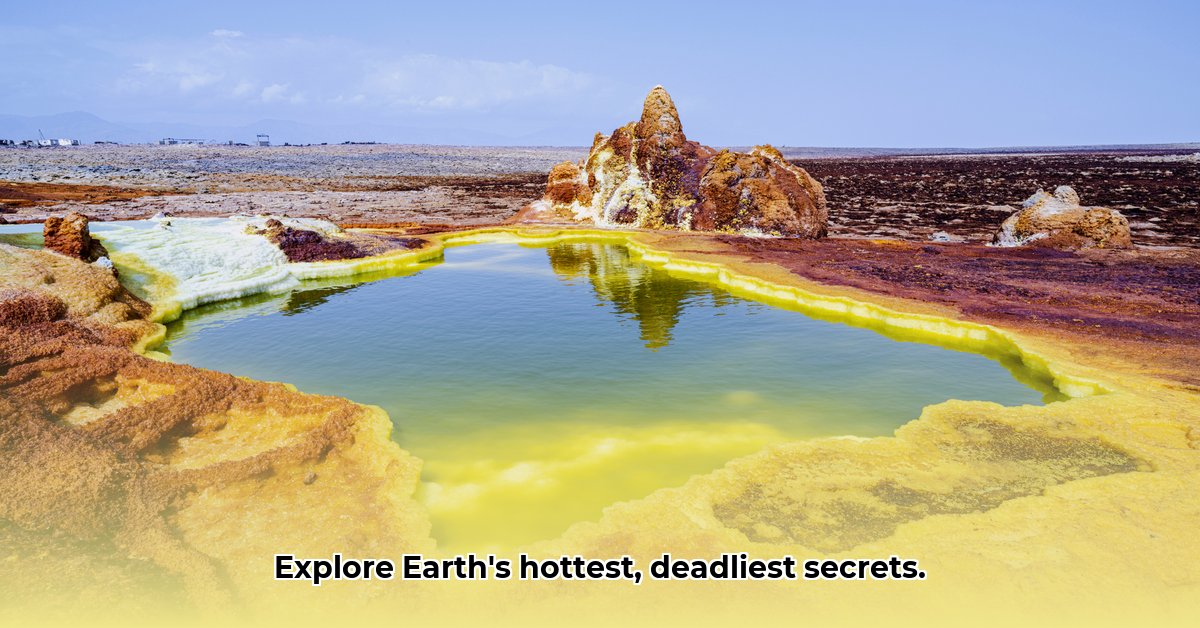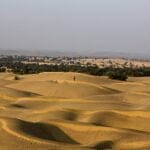The Danakil Depression, a scorching and geologically dynamic region, harbors a surprising abundance of life. This article delves into the scientific intricacies of this extreme environment, drawing comparisons with other extreme locales on Earth. We’ll explore its geology in a simple way, referencing top scientists. We will also consider the challenges and what the future holds for the Danakil Depression. This is an exploration into a living and breathing geological mystery, revealing the secrets of this remarkable place.
Danakil Depression: Earth’s Hottest and Lowest Point—A Geological Wonderland
A Fiery Expanse: Exploring Thermal Extremes
Envision a landscape where the air shimmers from relentless heat, and the very ground beneath your feet seems to simmer. This is the Danakil Depression, one of the hottest places on Earth, where temperatures routinely soar above 120°F (50°C). In this hostile environment, survival itself appears to be a remarkable achievement. How does such extreme heat sculpt the landscape and affect the life that perseveres here?
Tectonic Plates in Action: Witnessing the Rift Valley
The Danakil Depression resides within the Afar Triangle, a place where three tectonic plates—the African, Arabian, and Somali—are gradually separating. This geological phenomenon thins and lowers the Earth’s crust, creating a basin that plunges below sea level. It’s a dramatic display of planetary forces pulling apart the continent. How does this continental rift shape the region’s geological activity and its long-term evolution?
Volcanoes, Hot Springs, and Minerals: Unveiling Geothermal Wonders
Volcanic activity, exemplified by the persistent lava lake of Erta Ale, fuels intense geothermal processes within the Danakil Depression. When molten rock combines with water and ancient salt deposits, the result is Dallol, a surreal landscape of vibrant colors and bizarre formations. Are these geothermally active sites potential sources of unique mineral deposits, and how do they sustain extremophile life?
Extremophiles: Biodiversity Under Pressure
Despite the extreme conditions, the Danakil Depression is teeming with extremophiles—organisms that thrive in what is considered uninhabitable environments. These marvels inhabit super-salty, acidic pools, demonstrating the adaptability of life. Studying them provides clues about the limits of life and the possibility of life on other planets. What are the genetic adaptations that enable extremophiles to survive in these conditions, and could similar life exist elsewhere in the cosmos?
The Afar People: A Life Forged in the Heat: Balancing Tradition and Modernity
The Danakil Depression is the ancestral home of the Afar people, who have mined salt here for centuries. However, unsustainable mining practices and increasing tourism present serious challenges. Balancing economic development with environmental preservation is crucial for the continued well-being of the Afar and the preservation of this unique landscape. How can traditional practices be adapted to ensure long-term sustainability and protect the delicate ecosystem?
A Future in the Balance: Climate Change and Conservation
Climate change poses a significant threat to the Danakil Depression, potentially exacerbating its already harsh environment and endangering the livelihoods of the Afar people. Sustainable tourism practices and robust conservation efforts are vital to preserving this area and its unique biodiversity. What steps can be taken to mitigate the effects of climate change and ensure the preservation of this remarkable landscape?
Working Together: Protecting a Unique Place
The future of the Danakil Depression depends on collaboration and careful stewardship. Scientists are studying its geology and life, the Ethiopian government is implementing environmental policies, and the Afar people are contributing their traditional knowledge. International organizations are providing vital support. Only through collaborative management can we hope to safeguard this extraordinary region for future generations. What are the specific roles for each stakeholder in ensuring a sustainable future for the Danakil Depression?
Stakeholder Responsibilities: A Collaborative Effort for Long-Term Preservation
| Stakeholder Group | Short-Term Actions | Long-Term Actions |
|---|---|---|
| Scientific Community | Focused expeditions for data collection and research | Ongoing monitoring, global collaboration, genomic studies of extremophiles, promoting awareness |
| Ethiopian Government | Creating sustainable tourism plans and stricter regulations | Establishing protected areas, supporting sustainable resource management |
| Local Afar Communities | Supporting traditional salt mining through fair trade | Diversifying the local economy, promoting community-based tourism, preserving cultural heritage |
| International Organizations | Funding research and conservation, aiding in development | Supporting monitoring programs, capacity building, and promoting responsible tourism |
The continuing well-being of the Danakil Depression relies heavily on collaborative management and dedicated efforts to protect this extraordinary region.
Analyzing Extremophile Biodiversity in the Danakil Depression: A Scientific Guide
The Danakil Depression presents scientists with a unique opportunity to study extremophiles thriving in exceptionally harsh conditions. What methods are used to analyze extremophile biodiversity in the Danakil Depression?
Microbial Marvels: Unveiling Tiny Life: Genetic Analysis
Dallol, a hyper-extreme environment within the Danakil Depression, is home to polyextremophiles that flourish in highly acidic pools, near-boiling temperatures, and high salinity. Genetic sequencing and metagenomics are crucial tools for understanding their adaptations. How does comparing genes across different extremophile species shed light on the evolutionary pressures they face?
Fishy Adaptations: Life in a Brine Pool: Genetic Analysis
Two fish genera, Danakilia and Aphanius, have adapted to the Danakil’s fluctuating aquatic environments. Detailed genetic analysis, including phylogeographic studies, is essential to unravel their evolutionary history. By analyzing DNA variations, how can scientists trace the evolutionary history of these fish and detect the influence of environmental factors?
Geological Context and Geological Records: The Story in the Rocks
The geology of the Danakil Depression profoundly influences its extremophile life. Analyzing the geological record, including sediment layers and rock formations, provides valuable context for understanding their evolution. How does the timing of lake formation and recession provide insights into the emergence and adaptation of extremophile communities?
Challenges and Future Directions
Studying extremophiles in the Danakil Depression is fraught with challenges due to low organism numbers, slow metabolic activity, and the harshness of the environment. Future research will focus on more sensitive detection methods and improved sampling techniques. What kinds of improved detection and sampling techniques will be most beneficial in this extreme environment?
Key Takeaways:
- The Danakil Depression is home to a diverse array of extremophile life, highlighting the resilience of life under extreme conditions.
- Analyzing extremophile biodiversity requires advanced molecular techniques such as genetic sequencing and metagenomics.
- Understanding the geological history of the region is vital for interpreting the evolutionary history of these organisms.
- Further research is needed to improve detection methods and overcome logistical challenges posed by this extreme environment.
- The Danakil Depression serves as a compelling terrestrial analog for potential extraterrestrial environments.
Danakil Depression Geothermal Systems: Hydrothermal Activity and Extremophile Habitats
The Danakil Depression offers crucial insights into geothermal activity and extremophile habitats, providing a natural laboratory for studying life in extreme conditions. What critical insights do these habitats provide?
Key Takeaways:
- The extreme geothermal conditions support unique microbial communities.
- The extremophiles offer vital clues about life’s limits and extraterrestrial possibilities.
- The Depression acts as a valuable terrestrial analog for Mars.
- Further research is crucial for understanding these organisms and preserving the ecosystem.
The Infernal Landscape: Geology and Geothermal Activity
The Danakil Depression is sculpted by volcanic forces, where molten rock interacts with ancient salt flats, leading to the formation of hydrothermal vents. This hyper-saline, hyper-acidic environment, with temperatures exceeding 94°C, would be lethal to most known life forms. How does this unique chemistry create opportunities for extremophiles to thrive?
Thriving Against the Odds: Extremophile Life
The Danakil Depression’s microscopic life, primarily archaea, are extremophiles specifically adapted to withstand extreme salinity and acidity. Their resilience challenges our understanding of the fundamental limits of life. What genetic and biochemical mechanisms allow these organisms to thrive in such harsh conditions?
A Martian Mirror: Astrobiological Significance
The harsh conditions in the Danakil Depression bear similarities to hypothesized Martian environments, making it a valuable analog for astrobiological research. Studying extremophiles in this environment can inform our search for life beyond Earth. How does understanding these organisms improve our ability to detect life in similar extreme environments elsewhere in the solar system, and what life-detection tools can be further developed?
Challenges and Conservation
Studying the Danakil Depression presents logistical challenges due to its extreme conditions and remoteness. The area is also threatened by human activities, such as potash mining and unregulated tourism. Balancing scientific exploration with conservation and sustainable development is essential. How can we balance scientific progress with environmental protection in this unique and fragile ecosystem?
Moving Forward: Research and Global Cooperation
Ongoing research seeks to understand extremophiles’ unique adaptations, metabolic pathways, and the impact of environmental changes. International collaboration is essential for promoting responsible research practices and preserving this extraordinary environment. What advanced techniques are needed for identifying life in environments with such small microorganisms?
Danakil Depression Salt Deposits: Formation, Resource Management, and Sustainable Practices
The expansive salt flats of the Danakil Depression contain valuable resources but also pose significant challenges concerning sustainable management. How can we ensure sustainable practices in the face of increasing resource demands?
Evaporite Formation: A Story Written in Salt
Vast salt deposits formed over millennia as an inland sea gradually shrank under the relentless desert sun. As water evaporates, dissolved minerals, such as halite (common salt), precipitate out of the solution, creating immense salt pans and complex mineral formations. How does the Danakil Depression’s unique geological setting contribute to the scale and composition of these evaporite formations?
Resource Management: Navigating a Delicate Balance
Salt mining has long provided a vital livelihood for the local Afar people, but it also poses environmental risks, including habitat destruction and potential pollution. Balancing economic development with ecosystem preservation is essential for the long-term well-being of both the people and the environment. How can we ensure that extraction practices are sustainable and minimize environmental damage through community engagement and responsible environmental stewardship?
Extremophiles and Ecological Footprints
The Danakil Depression is home to extremophiles that are particularly vulnerable to human activity and habitat disruption. Understanding and minimizing the ecological footprint of salt extraction is crucial for preserving this unique biodiversity. How can we minimize the ecological footprint of salt extraction while simultaneously safeguarding extremophile habitats?
Looking Ahead: A Sustainable Future?
The future of the Danakil Depression’s salt deposits depends on the adoption of sustainable practices, robust environmental protection measures, and the empowerment of local communities to participate in resource management decisions. This challenges us to promote responsible stewardship of this exceptional environment.
Key Takeaways:
- The Danakil Depression’s salt deposits are massive evaporite formations, resulting from millennia of evaporation.
- Salt extraction provides economic opportunities but necessitates the implementation of sustainable practices.
- Protecting the unique ecosystem, including extremophiles, is a paramount concern.
- Successful resource management requires close collaboration between local communities, government agencies, and industry stakeholders.
- The future of salt extraction in the Danakil Depression hinges on achieving a delicate balance between economic development and environmental sustainability.
- Unlocking Ada Lovelace’s Secret: The First Computer Programmer’s Vision - July 31, 2025
- Revolutionizing Knowledge: The Printing Press and a New Age - July 31, 2025
- Unlock Da Vinci’s Genius: To-Do Lists Revealed - July 31, 2025
















